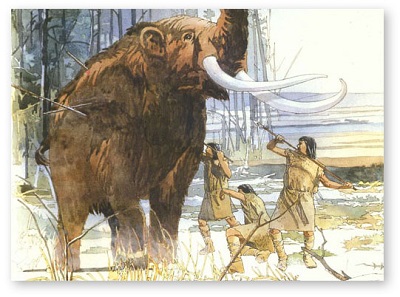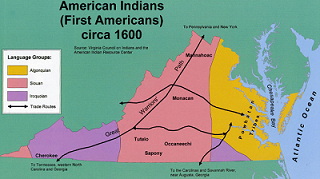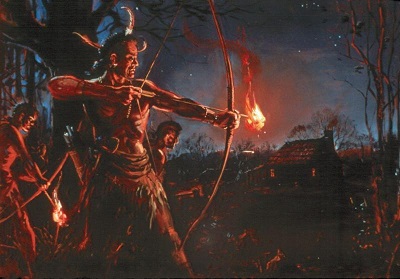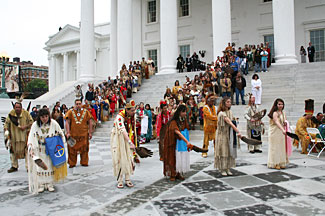The First People

Photo courtesy of Ed Jackson
Native Americans had lived in Virginia for at least 16,000 years before the English colonists arrived. Archeologists divide Native American history into three time periods. The Paleo-Indian, the Archaic, and the Woodland. These periods emphasize different features of Native American culture. The Paleo-Indian period occurred between 15,000 and 9,000 years ago. During this time early humans came to the New World across the Bering Strait. The Bering Strait is a land bridge that connected Asia and North America. Archeologists believe early humans were following large mammals like mammoths and bison. These groups moved often and left little traces of their existence. The Williamson site in Dinwiddie County is a Paleo-Indian workshop. It is one of only four Paleo-Indian workshops in the eastern half of the United States. Paleo-Indian workshops, or quarries, are areas where Native Americans made stone tools. (The site was not included in the List of Sites because it is not open to the public). The next period is the Archaic Period, which occurred between 9,000 and 1,000 years ago. By then large mammals like mammoths and bison were extinct. Early humans began hunting deer, elk, bear, and small game like rabbits. They were also gathering plants such as fruits and acorns. The Woodland Period began 1,000 years ago and lasted until European contact. By this time Native Americans were more sedentary. They were making fired clay pots for cooking and storage. They settled in large communities of hundreds, sometimes thousands, of people. These communities relied on farming for their food. Vegetables like squash, beans, and corn were important to their diet. They continued hunting and using all parts of the animal for food, clothing, and tools. Native Americans lived and used the land without permanently destroying it. This is why it can be hard to find well preserved Native American sites. There are a few remaining sites in Virginia. The Conjurer’s Field Archaeological Site is an example of one of the few remaining Middle and Late Woodland period villages located along the Appomattox River.
Virginia Native Americans: Pre-European Contact

Courtesy of Virginia Council on Indians and the American Indian Resource Center
Native Americans in Virginia lived in three language groups in different areas of the state. Each language group had its own beliefs, traditions, and customs. Algonquin speakers lived in the Tidewater region of Virginia. The Tidewater is the easternmost region of Virginia. Experts estimate that there were 25,000 speakers in 30 different tribes. Each tribe had its own name such as Pamunkey, Appomattox, Weyanoke, and Mattaponi. Today, Weyanoke is an unincorporated community in Charles City that was named after the Weyanoke tribe. The community is located on Weyanoke Peninsula and is home to the Upper Weyanoke Plantation (no longer accessible to the public), North Bend Plantation, and the Westover Plantation. Many of these tribes were part of the Powhatan Confederacy. Their chief was Wahunsenacawh, or Powhatan. He united the tribes to create a union among the tribes in the region after the Spanish drove his father to the north. The Powhatan Confederacy was headquarted at Werowocomoco when the English arrived in 1607. (Werowocomoco is not yet accessible to the public, please check Werowomoco-Planning for updates.) The confederacy provided armed support and paid taxes in the form of food, animal furs, copper, and pearls. At its peak the confederacy covered an area of 16,000 square miles. These tribes lived in settled villages near the James River, or one of the many rivers that feed it, where they were able to farm the land. Though Powhatan had many children, Pocahontas was the most famous.
The Siouan speakers lived in the Piedmont region of Virginia. This is the region to the left of Tidewater and to the east of the Blue Ridge Mountains. Siouan groups, like the Monacan, lived in villages surrounded by a high fence, called a palisade. There is much less written information about the Monacan because they did not trade with the English. The Monacan tribes were enemies of the Powhatan and were often at war.
The Iroquoian speakers lived in the Appalachian Plateau of Virginia, near what is now North Carolina. The Appalachian plateau is the area of Virginia to the left of the Blue Ridge Mountains. Five tribes banded together to form the "Five Nations": the Mohawk, Onondaga, Oneida, Cayuga, and Seneca.
European Interaction with Native Americans

NPS; Sidney King, artist
From the beginning tensions between the English colonists and the Powhatan Confederacy were high. Each group felt superior to the other. English survival depended on help from Native Americans. When the Native Americans would not give them food, the English began stealing and burning Native American houses. Out of frustration, the Powhatan’s captured Captain John Smith and others in 1607. According to popular legend Captain Smith was saved from death by Pocahontas, Powhatan's daughter. In his own memoirs, Captain Smith does not mention Pocahontas until 1624 after she became famous. After Captain Smith was let go, Powhatan agreed to supply the colonists with corn. By 1608 the Powhatan Confederacy and the colonists became allies and trading partners. The Native Americans provided food, furs, and leather. The colonists provided metal tools, guns, and pots and pans. Conflict remained. The Powhatan’s realized that the colonist’s settlement would continue to grow. In 1614, Pocahontas married John Rolfe, who introduced Caribbean tobacco to the colony. They had one son, Thomas in 1615. This brought temporary peace. Pocahontas died in England in 1617 from disease. Chief Powhatan died a year later. Opechancanough became the new chief.
In 1622, Chief Opechancanough attacked the colonists in the plantations around Jamestown. This event became known as the Indian Massacre of 1622. Three hundred fifty colonists died in the attack. This was a quarter of the Jamestown population. The massacre was the greatest at Martin’s Hundred, the location of Carter’s Grove plantation today. The English waited for reinforcements and weapons. Once reinforcements came, the colonists began raiding the tribes. They were so successful that Chief Opechancanough decided to negotiate. Captain William Tucker and Dr. John Potts agreed to a peace agreement between the two groups. Captain Tucker and Dr. Potts poisoned wine and gave it to the Powhatans. Two hundred Native Americans died from the poisoned wine and the colonists killed 50 more. This started a war between the two groups that lasted ten years. Constant war slowed the growth of the English settlement and weakened the power of the Powhatan Confederacy. This war (1622-1632) is known as the Second Anglo-Powhatan War.
The Third Anglo-Powhatan war occurred in 1644. In April 1644, the Powhatan’s attacked the English. Like other attacks, this attack was meant to correct the colonist’s inappropriate behavior. Sir William Berkeley, the new Royal Governor, fought back and won. This time 400 colonists were killed. The next year the English attacked Chief Opechancanough’s fort. It is unknown how many Native Americans died in this attack, but hundreds were sold into slavery. Chief Openchancaough was captured and shot in the back by a guard.
By 1705, only a few tribes descended from the Powhatan Confederacy existed. Diseases caught from the Englished killed many of the Native Americans. Those that survived were sent to live on reservations.
Virginia Native Americans Today

NPS
It is a common misconception that war and disease killed all of Virginia's Native Americans. There are thousands of people who still identify as Native American living in Virginia. Today, the only federally recognized tribe in Virginia is the Pamunkey. There are 10 tribes that are recognized by the state of Virginia. These are the Mattaponi, Chickahominy, Eastern Chickahominy, Rappahannock, Upper Mattaponi, Nansemond, Monacan, Cheroenhaka, Nottoway, and Patawomeck.
Last updated: August 16, 2017
